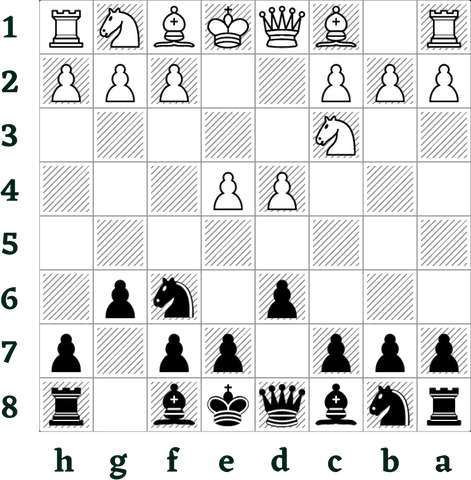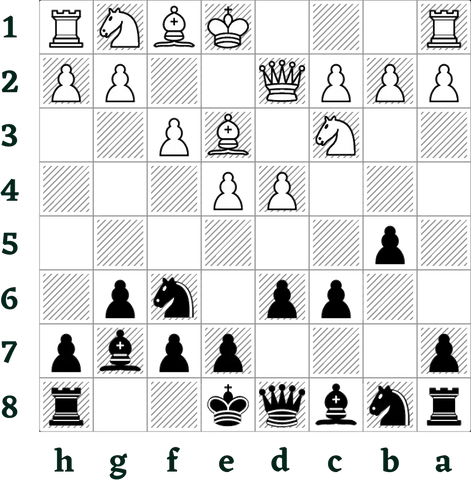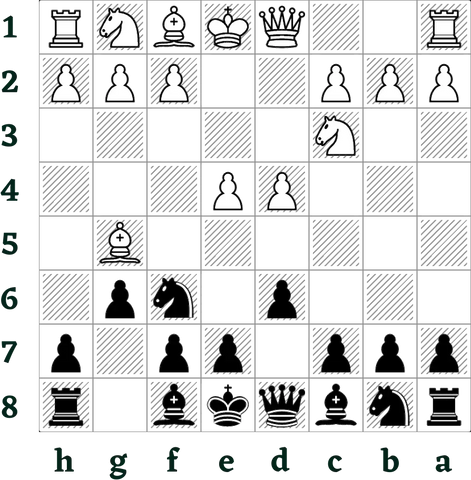
Chess Opening: The Pirc Defence
Share
The Pirc Defence is named after the Yugoslav chess player Vasja Pirc. As a representative of this opening, Pirc won several titles in his country between the 1930s and 1950s and took part in the Chess Olympiad with Yugoslavia six times. In Russia, the opening is also attributed to the Kazakh-Soviet chess master and theorist Anatoly Ufimtsev, which is why the term Pirc-Ufimtsev Defence is often used in the literature. Even though Pirc and Ufimtsev actively influenced chess and chess theory in the first half of the 20th century, the Pirc-Ufimtsev Defence only became more popular from the 1960s onwards. The Canadian chess grandmaster Duncan Suttles increasingly favoured this opening and it was even played by Bobby Fischer against Boris Spassky in 1972.

The main variation of the opening involves the following moves:
1.e4 d6 2.d4 ♘f6 3.♘c3 g6
In this chess opening, Black initially starts with a passive pawn move, which allows White to capture the centre with 1.e4 and 2.d4. However, with 3...g6 Black reveals a flank attack which, with a bishop move on g7, is strongly similar to the King's Indian Defence. Nevertheless, the Pirc Defence is considered risky, as it gives White a lot of freedom of choice in the opening phase of the game.
Strengths of the Pirc Defence
The Pirc Defence offers a number of strengths that can be used against the opponent:
- Tactical Focus:
The Pirc Defence requires but also allows for very tactical play. Since White can dictate the course of the game due to Black's passive style of play, Black has the opportunity to initiate a counter-attack through skilful tactics.
- Similarity to the King's Indian Defence:
Due to the possible fianchetto, there is a high similarity to the King's Indian Defence. Black therefore has the opportunity to acquire more theory. However, it should be noted that the sequence of moves is different and, for example, the fianchetto in the Pirc Defence is slightly delayed.
- Counter-Attacking Possibilities:
The aim of this defence is an initially passive style of play, which then initiates a counterattack on the centre in the transition to the middlegame. The fianchetto supports this and strengthens the bishop on the dark squares. The potential of the counterattack essentially depends on White's style of play.
Weaknesses of the Pirc Defence
Like every opening, the Pirc Defence also has its weaknesses that need to be considered:
- Passive Start of the Game:
The Pirc Defence leaves White a lot of space in the opening phase, which is why the White player can develop his opening strategy unhindered. Black is therefore faced with the challenge of having to be armed against all of White's possible openings. This represents a high tactical challenge and requires experience.
- Unconventional Style of Play:
The defence requires a high degree of flexibility in Black's style of play. Due to the freedom granted to White at the beginning, Black must also adapt to White's course of play. The demands on tactical skill are correspondingly high.
- Difficult to Time:
The strategy of the Pirc defence relies on a counter-attack on the centre. However, this requires good timing so that the attack on the centre can be carried out by Black before White launches his attack. This is because there is a high probability that Black will not be able to repel White's attack.
Possible Variations of the Pirc Defence
Since the Pirc defence is considered to be very risky, most games show the dangers that White can bring in. The following variations may therefore give the impression that they are described from the position of the white player. As the black player, the course of the game should therefore be analysed against the background of possible counter-attacks.
Classical Course

Chess Moves:
1.e4 d6 2.d4 ♘f6 3.♘c3 g6 4.♘f3 ♗g7
In the classic line, White plays his second knight and Black plays the fianchetto with his bishop. In this constellation, White is very likely to develop his f-bishop. Both sides can then castle or initially trade with their pawns in the centre. This depends on the aggressiveness with which White brings his bishop into play. A bishop on e2 enables castling via the slightly passive style of play, while the bishop on c4 requires Black to defend the d5-square. Both developments are balanced and lead to a tactical middlegame.
Austrian Attack

Chess Moves:
1.e4 d6 2.d4 ♘f6 3.♘c3 g6 4.f4
The Austrian Attack is characterised by an offensive advance of the white pawn chain. After Black has prepared a fianchetto via g6, White moves his pawn to f4 and controls the squares g5 to c5 on the 5th rank. Black can launch a counter-attack here with e5 and initiate an exchange of pawns. However, this course of play gives the white player a slight advantage. As the black player, a high degree of tactical skill is required to counter the Austrian attack. The attack is one of the most aggressive responses to the Pirc defence and has been successfully played by well-known chess players - including Bobby Fischer.
150 Attack

Chess Moves:
1.e4 d6 2.d4 ♘f6 3.♘c3 g6 4.♗e3 ♗g7 5.♕d2 c6 6.f3 b5
The 150 attack is a very famous variation, but it deals less with the suitability of the defence and more with White's counter-attack. The game shown here was played at a traditional international tournament in Wijk aan Zee in 1999. It shows the opening phase of the opponents Garry Kasparov (White) and Vesselin Topalov (Black).
In this game, White used his bishop and queen to launch an attack on the kingside via the h6-square. Both sides then castled long to the queenside. For Black, this castling was forced and meant a loss of tempo. From then on, the king was also protected by a weakened pawn structure, which was already in the advance for a planned attack. Later, White sacrificed both rooks, creating the sensation of the game and ensuring Kasparov's victory. Years later, he described this game as the best he had ever played. Although the course of the game is not a representative example of the outcome of the Pirc Defence, it is probably the best example of the high tactical demands of this opening.
Byrne Variation

Chess Moves:
1.e4 d6 2.d4 ♘f6 3.♘c3 g6 4.♗g5
The Byrne Variation launches an early threat with its bishop on g5. Black is faced with the problem of evaluating the danger of an early pawn advance on the e-file. A common move for Black would be to move the bishop to g7, but this could be a loss of tempo if he exchanges on h6 in the course of the game. Alternatively, an advance on the centre or the queenside can be threatened with c6 and the b-knight developed on d7. The defence of the bishop on g5 is achieved with the previously mentioned move h6. As the game progresses, Black tries to break through with his fianchetto and the pawn advance on the queenside. White will try to stop these efforts by attacking the centre. White would even favour an early queen exchange on d1 in order to include the rook (the b-knight on d7 would counter this early on).
Conclusion
The Pirc Defence is a very tactical and risky chess strategy that demands a high level of theoretical knowledge from the black player. The problem with the defence lies in the passive style of play in the opening phase, which gives White a great deal of freedom to shape his own opening strategy. Although this gives Black the option of a counter-attack, he must be familiar with White's many possible openings in order to be able to react accordingly. This fact makes the Pirc Defence an opening that should rather be used by experienced chess players, at least in tournament games.
I hope that I have been able to give you a good overview of the opportunities and risks of the Pirc Defence. If you have any further questions, please write to me using my contact form. And if you are interested in chess pieces or chess boards in tournament format, please take a look at my product range.
I wish you lots of fun with the game, much success and rapid progress with your learning.
See you soon.
Stefan
